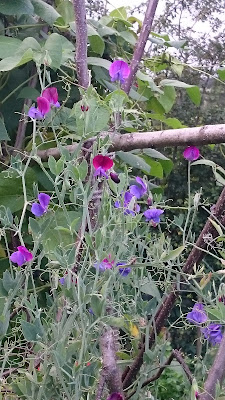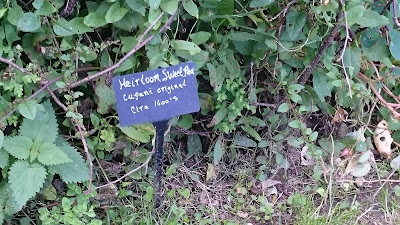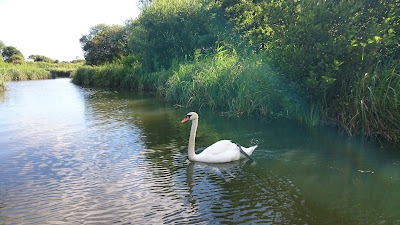"In the bleak midwinter, frosty wind made moan, earth stood hard as iron, water like a stone; . . ." These are the first few lines from the carol written by Christina G. Rossetti (originally as a Christmas poem for the American magazine, Scribner's Monthly, in 1872) and, as I stood in the dark, silent woods with a small group of people and only a few paraffin lanterns to cast a weak light around us, I became aware of how much light there still was in the evening sky.
Through the branches of the trees, now mostly bare after the gales of last week, I could see a faint twilight over the hills and, overhead, there was already a fantastic display of stars. Nearby, I caught the faint smell of woodsmoke as well as the gentle noise of someone shuffling their feet, whilst we waited for the walk leader to begin speaking.
He told us about a time, almost 1000 years ago, when people in this part of Britain knew that there was nothing 'out there' in the dark that would eat them (the remaining brown bears and wolves having been driven North by hunting) and that they would have been comfortable to navigate around their local area without light of any kind, which was very important given that their only portable light source was inefficient tallow candles.
We moved onwards through the woods, the deep litter of leaves rustling and crunching under our feet. When my eyes adjusted to the dim light, I could see the glitter of frost riming the top layer of leaves and glittering on bare earth and stone.
As we passed the new Anglo Saxon hall house I became aware of the red glow of firelight in the trees ahead and shortly, on our right, we were lead to an area with a campfire glowing red, orange and white with heat and a small canvas tent with a lantern in the entrance close by. Here, we were told, was the camp of a charcoal burner who would have had to maintain a round the clock vigil whilst 'the burn' was taking place. The speaker, a Woodsman himself, went on to explain that charcoal burners only lived in the woods from Spring to early Autumn when they were working to produce charcoal and that, at other times, they lived in houses which were comfortable and well furnished as they earned good money from their trade, as shown in Wills and other legal documents.
Walking further through the woods I slipped on an icy patch whilst navigating a slope and was very glad that my husband was stood next to me and caught me before I fell. Eventually we reached Pendean Farmhouse and entered, grateful to be leaving the deep cold behind us. The fire and a few candles cast a welcoming light though reading and sewing would have been out of the question and our guide explained that whittling was a pastime that would have been carried out during the darkest months of the year.
Outside again, I stopped and gazed up into the heavens slightly awed by how crystal clear the stars and constellations looked in a night sky unpolluted by electric light.
In the dark, I walked tentatively down a cart track made slippery by the build up of several day's frost, glad for once of the need to use walking sticks which gave me extra support.
The next stopping point was Bayleaf, a Tudor framed hall house. Whilst the high-ceilinged hall was much darker than the much smaller rooms in Pendean, we were told that spinning and tool making/repairs were important jobs that would have been done by the light of the fire. We also discovered that, before artificial lighting was widely available, people's sleep patterns were very different from now and usually consisted of two periods of sleep with an hour (or so) or wakefulness in the early morning hours, known as biphasic sleep.
When we left the warmth of Bayleaf's open hearth fire behind, I was aware of how intensely cold the night air had become. We were walking in a very spread out group and this meant I could get a greater feel of walking in the dark as I did not have a lantern. Moving away from a sparsely candlelit environment I noticed how quickly my night vision returned.
I heard the sound of hooves stamping on cobbles and realised that the museum's three heavy horses were in the fenced paddock on my left and, in doing so, I glimpsed their outlines as I passed by on my way to Whittaker's Cottages. These were constructed in the Victorian period and so the interior appeared very modern, compared to all the other houses we visited. The most useful innovation we saw here was the paraffin lamp which meant that all sorts of handiwork as well as reading would have taken place well into the night.
Our last house of the evening was Walderton, a short step across the green from Whittaker's Cottages. The three steps up to the front door were tricky in the almost total dark so it was a relief to find a fire in the hearth and a comfortable chair to sit in.
We were the last people to leave the house and one of the guides shone a light to help us down the steps, though inexplicably turned it off as my husband was mid-step which lead to him falling in a rather dramatic, though apparently casual, fashion as he had his hands in his coat pockets. Afterwards he told me that he didn't see much point in panicking as there was nothing to grab onto, so he harnessed his stage training to fall as well as was possible. At the time we thought he had completely got away without damage, however the next morning he discovered a huge purple bruise on his right side. All in all, he still felt (and I agreed) that he came out of it well all things considered.
After this bit of unexpected excitement it was a relief to reach the building from Lavant where hot mulled wine, warm spiced ginger cordial and mince pies were being served. When we left a short while later, we found our path to the car park illuminated by the paraffin lamps that had been carried around the site on our walk which was a lovely way to finish the evening.
The guided walk we attended was at the Weald and Downland Open Air Museum .

















































